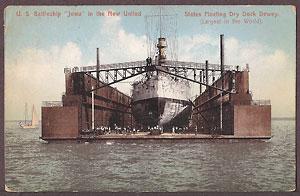Beverly, NJ | View Map

The steamer Bristol pulls away from the Beverly dock at the foot of Broad Street in 1909. By the 1870s there were five steamboats to Philadelphia each day; the trip took a little over an hour. Regular steamboat service operated on the Delaware until the 1920s. Credit: Historical Society of Riverton
Beverly began as a ferry crossing and transportation continued to be a major theme in this small borough’s history. Today’s Beverly encompasses two earlier settlements. A small crossroads community grew up around the New Jersey terminus of Dunk’s Ferry, an important river crossing created in the 1690s for the first English settlers. An inn was established at the ferry crossing in the eighteenth century and was in business for 130 years. Churchville, a settlement located east of present-day Cooper Street, developed around the area’s first houses of worship in the 1830s.
The transition to a modern village began with the arrival of railroad and steamboat service in the 1830s and 1840s. In 1834, the Bordentown-Camden leg of the Camden & Amboy Rail Road (C&A) was built through here. Construction of a steamboat wharf in 1847 soon drew passengers and freight from surrounding farms. Developers sensed a real estate market poised for growth with these new transportation connections in place. They bought a 75-acre tract around Dunk’s Ferry in 1847 and began advertising a healthful and picturesque setting to prospective tourists and residents. By 1848 a new town called Beverly was laid out, and the following year the C&A built a rail station in the village.

Beverly fisherman Edward Bintliff mending his shad nets in 1940. According to the photographer, Bintliff complained at the time about the drastic reduction in the shad population. In 1901, he told of netting 200 fish per haul; by 1940 a good haul was 20 shad. Credit: William F. Augustine Collection, Special Collections and University Archives, Rutgers University Libraries
Although no Civil War battles were fought in New Jersey, in the 1860s village residents saw the human cost of warfare firsthand. Wounded Union soldiers overwhelmed existing hospitals and an industrial building near the railroad was converted into a makeshift convalescent facility. In 1864 the U.S. government established a military cemetery nearby, between Cooper and Broad Streets. The Beverly National Cemetery (now within the boundaries of Edgewater Park Township is one of 146 national military cemeteries. The 65-acre site contains nearly 50,000 graves of veterans from the Civil War through World War II, including four recipients of the Medal of Honor. It is listed in the National Register of Historic Places.
The decades between 1850 and 1900 were peak growth years. Rail and steamboat connections expanded quickly. An 1873 promotional pamphlet noted that there were twelve trains to Philadelphia and eight trains to New York six days a week from Beverly station. Steamboats to Philadelphia called at the Beverly docks five times a day; in 1874, the equivalent of 63,000 round trips to Philadelphia was sold here. Transportation options expanded further with the arrival of a Camden-Trenton trolley line in 1901.

Wall Rope Works produced natural and synthetic rope products for military, industrial and maritime use. In 1906, the U.S. Navy used 110,000 pounds of Wall Rope to tow this enormous floating dry dock from the East Coast to the Philippines, a record-breaking 12,000-mile trip. Credit: navsource.org
Access to growing cities and expanding markets for consumer and industrial products attracted new industries. Beverly’s leading factories included a textile mill and a large rope (cordage) factory. Wall Rope Works, located near the railroad, was an industrial complex of national importance. The heart of the factory was its ropewalk, a long narrow building where strands of material were laid and twisted into rope. The 1,700 foot-long facility was the largest in the U.S. The company supplied rope products for the military beginning with the Spanish-American War; its products were used in the construction of the Kennedy Space Center.
The Borough of Beverly was established within Willingboro Township by the Legislature in 1850; it became a city in 1857. With an area less than one square mile, Beverly is one of the smallest cities in the state and has a population of 2,661. By 1920, most of Beverly City was fully developed and after World War II growth shifted to adjacent rural areas. Since the departure of manufacturing firms that formed the backbone of Beverly’s economy for decades, the town has struggled to redefine itself. Redevelopment efforts aim to revitalize the waterfront area with a mixture of commercial and high-density residential development and improve the area surrounding the Beverly-Edgewater Park light rail station.
For more information:
- https://en.wikipedia.org/wiki/River_Line_(NJ_Transit)
- www.beverlybee.com
- www.cem.va.gov/cems/nchp/beverly.asp
- www.co.burlington.nj.us
- www.njtransit.com
Banner art: “It is situated at a high elevation above the river and enjoys entire freedom from malarious influences incident to low and marshy land. It has broad and shady streets, churches and schools, and has the reputation of being an exceptionally well-governed and orderly town.” Suburban Homes, 1880. Credit: Engraving by David Scattergood, Scattergood’s Delaware River: from Trenton to the Sea, 1878. Special Collections and University Archives, Rutgers University Libraries






